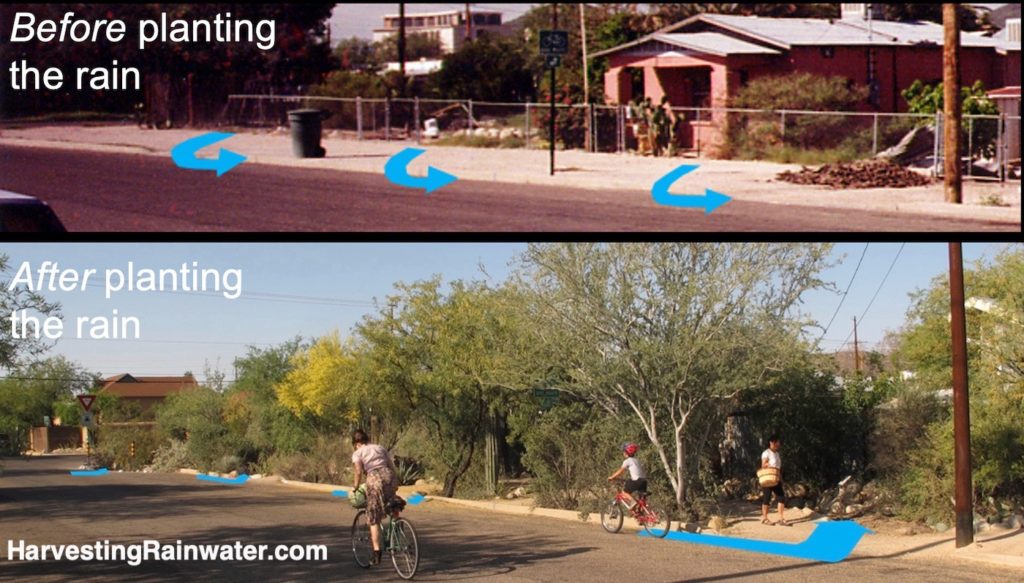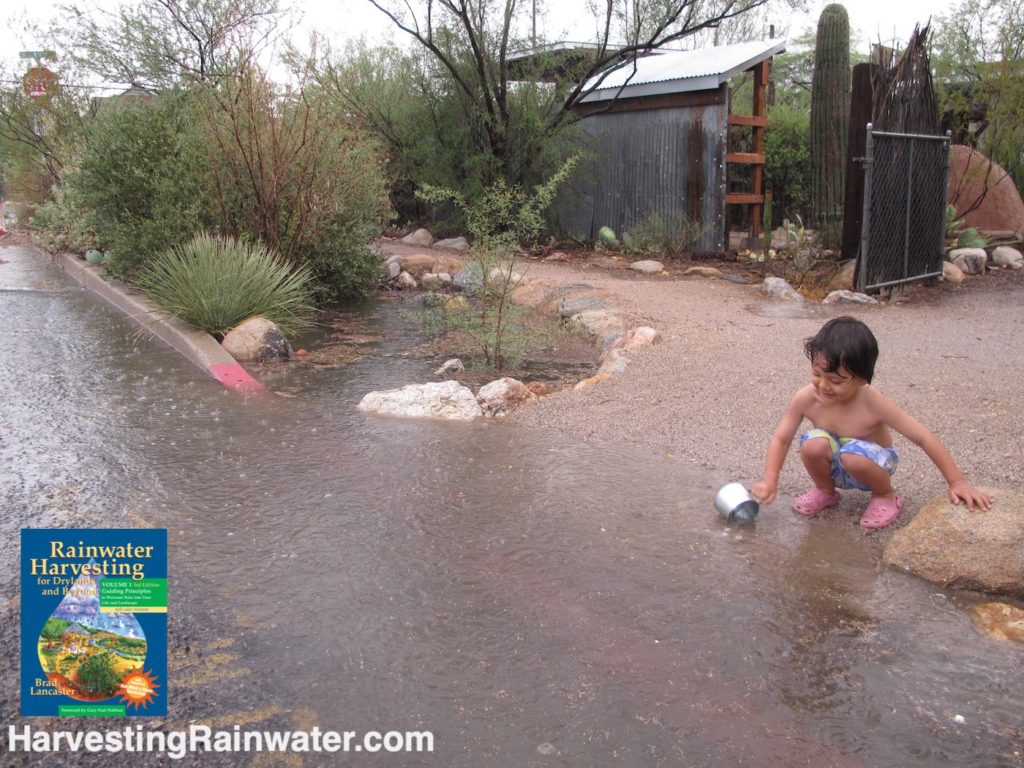Lancaster Family Regenerative Living Laboratory & Home
This 1/8th-acre residential site and the adjoining public right-of-way harvests about 100,000 gallons of rainfall and stormwater per year where average annual rainfall is 11 inches. So, we are able to put more water back into the local hydrologic system (with harvested rainwater and stormwater) than we take out (via the municipal water supply).

Blue arrows denote water flow.
Trees were only 5-gallon-size when planted. All other plants were just 1-gallon-size or planted in-situ from seed.
Photos: Brad Lancaster
We harvest most of our free, on-site waters within the soil and vegetation via water-harvesting earthworks or rain gardens freely watering native food forests.
Roof runoff is captured in tanks or cisterns, so it is easily available in dry times for drinking, cooking, bathing, washing, and irrigating vegetable gardens. Rainwater tank overflow is directed to rain gardens.
All household greywater is directed via gravity (no costly pumps) to rain gardens (no costly tanks) to provide irrigation water in times of no rain.
So…
• rainwater is the primary water source,
• greywater is the secondary water source (for landscape irrigation),
• and municipal water is the third or supplemental water source in times of true need.
Passive sun and shade harvesting strategies give us free heat and light in winter and free shade and cooling in summer.
As one of 24 site-built composting toilet pilot project sites, we helped legalize the barrel composting toilet system state wide, and all is now fully permitted. So, we no longer have to crap into the water cycle via drinking water in a flush toilet and turn it into sewage. Instead, we make our deposits in the carbon cycle via the waterless compost toilet as we safely turn human waste into a safe and fertile soil amendment.
We started harvesting street runoff in street-side basins by extending the basins to existing driveway dips in the street curb. This worked so well, that we wanted to harvest street runoff in areas where there was no dip in the curb.

Photo: Brad Lancaster, 2011
So, we made what may have been the first street-runoff harvesting curb cuts when this was pre-legal. Then we kept improving our design, and approached the City to legalize the practice. We succeeded and worked with City staff to improve the practice. We continue to improve and evolve this system through our work with the Dunbar/Spring Neighborhood Foresters annual rain & native food forest plantings. Now it’s also incentivized with rebates and mandated in new road construction and repair (though this still needs more improvements and enhanced enforcement from the City).
The appearance of our landscape may be a little rough or wild for some, but those wanting a more manicured look, can have that while still having the ecological functions we’ve realized. You just have to put more time and resources into the manicuring.
For more information and images:
Read chapter 5 of Rainwater Harvesting for Drylands and Beyond, Volume 1, 3rd Edition
and check out the following links:
Lancaster residence image gallery
Video of multi-pipe laundry greywater harvesting
Video of greywater-harvesting outdoor shower
Video tour of Lancaster property and neighborhood from 2018
Sun- and Shade-Harvesting Cisterns
Garottage Passive-Solar Design and Art
Sun- and Shade-Harvesting Mirror
Passive-Solar Retrofit to Enlarge Winter-Sun-Facing Window
Where:
813 N. 9th Avenue
Please respect the privacy of this residence, and do NOT visit the private property in person, unless you have arranged a tour – see below.
32.23213, -110.97347
Hours and cost:
For scheduled tours,
check Brad Lancaster’s Events page (these tours usually occur in the cool months, the first Sunday after a Watershed Management Water Harvesting Certification Course, and sometimes after monsoon rains too)
Also check Neighborhood Foresters Events page for events you can participate in
The public path and its bilingual signage in the public right-of-way adjoining the property is always open and free.
This location is included in the following tours:
See the new, full-color, revised editions of Brad’s award-winning books
– available a deep discount, direct from Brad:

Volume 1

